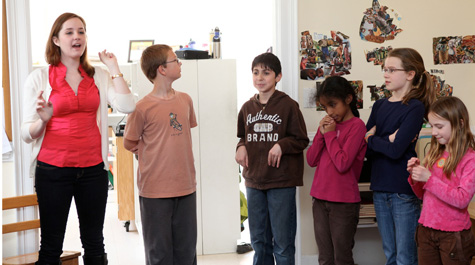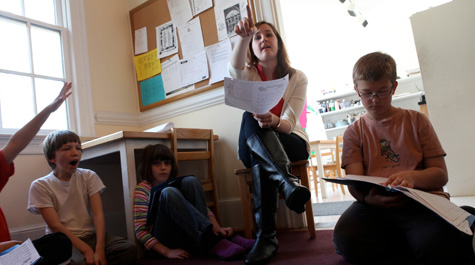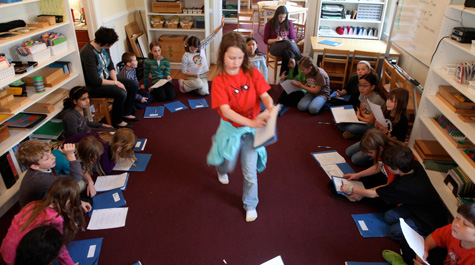Senior's music project benefits local schoolchildren
In her classroom, Kate Tidaback ’11, a music and psychology double major at William & Mary, is better known as “Ms. Kate.” Her class takes place every Monday afternoon at the Williamsburg Montessori School, and her students are 9-to-12-year-olds.
As part of her senior music project, Tidaback is spending her final semester as an undergraduate working at the school in a new partnership between it and the William & Mary music department. In addition to conducting research into elementary music education techniques and leading her students in an end-of-year concert, Tidaback visits the school for a half-hour every week to teach a class.
She begins each lesson by leading the 25 grade-schoolers through warm-ups borrowed from Reveille, the all-female a cappella group Tidaback directs on campus. Then it’s down to business.
“I’m used to teaching musical things to people, but I’m used to teaching people my age,” Tidaback said. “It’s a totally new experience with kids that young because I was that age 10-plus years ago and I don’t remember what I knew back then. At first I didn’t know what they knew and what I still needed to teach them.”
Last year, Music Professor Mary Fletcher was asked by Williamsburg Montessori school teacher Beth Wheeler if she knew any students who might be interested in helping to establish a partnership between the two schools. Fletcher immediately knew Tidaback was the right student for the assignment.
“I always enjoy helping the music majors who study voice with me find senior projects which will further their growth in the field of music,” said Fletcher, “and I am so pleased that this is coming to fruition.”
Tidaback, who is currently applying to various graduate programs in music education while at the same time managing her weekly lessons with the Montessori students, said she was nervous but flattered when Fletcher told her about the opportunity.
“It’s really exciting that I get to do something like this,” Tidaback said.
As a senior, Tidaback is required by the music department to either perform a recital in her primary instrument of study -- in her case, voice -- or conduct a research project that will culminate in a paper or presentation. After she was put in touch with the Montessori school, Tidaback received permission to use her work with the students as her senior project, to be accompanied by a 15-page paper detailing her preliminary research and “any interesting things that happened along the way.”
It was this preliminary research which led Tidaback to a Hungarian music theorist named Zoltan Kodaly. Kodaly, after observing the subpar musical teaching methods common in the 1940s, invented a system of movable solfege symbols which are still in use today, although they are better known as the syllables in “Do-Re-Mi” from “The Sound of Music.”
Studies have since shown that Kodaly’s method, if taught to children when young, gives them a basis for reading music at an earlier age. Before she began her first lesson, Tidaback did research into the Kodaly teaching style, and discovered that it works well with the Montessori school’s philosophy of children being self-motivated to learn.
Ever since her first class in mid-February, wherein, according to Tidaback “I introduced myself, told them what I was doing there, and then we just sort of went at it,” the music major has been working with the students in her class on preparing a handful of short pieces for their America- and Virginia-themed end of year recital.
She continues to be surprised by the level of music knowledge and intuitiveness they bring to each class. For example, while working on a piece called “My Thoughts Are Free,” Tidaback asked the assembled students where they thought the piece might have come from. One of the young students gave an answer about the freedom of the mind among oppressed peoples.
Tidaback was also surprised by the musical tastes of her students, which she said have been heavily influenced by “Glee.” One day she asked the class what songs they liked and received answers such as “Dynamite,” a dance-pop song which reached number two on the Billboard 100, and was recently covered by the cast of the popular TV show.
“I was really surprised,” she said. “I did not listen to music that cool when I was 10.”
As the Montessori students’ final recital in April draws closer, Tidaback said that she has been challenged, entertained, and sometimes even intimidated by her task with this class, but noted that, if nothing else, this experience has confirmed her desire to become a music teacher.
“I really like the idea of being a kid’s first exposure to music,” she said.


















